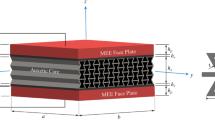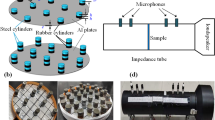Abstract
Within the field of hearing prosthetics it is known that patients with sufficient residual hearing benefit from the simultaneous employment of hearing aid and cochlear implant. Several attempts have been proposed to combine the sources of the corresponding acoustic and electric stimuli in a single, implantable device. However, since only little is known about the effect of also applying the acoustic stimulus locally from within the inner ear, the current state of research lacks detailed knowledge on the optimal stimulation at the corresponding bionic interface. Within this manuscript, a simple but yet physiologically-based inner ear model is presented which was designed specifically for the analysis of local acoustic or mechanical inner ear stimulation. A detailed model analysis is performed showing that it is capable of mirroring the known mechanical phenomena of this particular stimulation approach. Using the model, it is demonstrated how amplitude and phase shift values of stimuli applied from within the inner ear should be chosen for optimal inner ear stimulation.












Similar content being viewed by others
References
G. Békésy, Experiments in Hearing (University of Michigan, McGraw, 1960)
H. Bernhard, C. Stieger, Y. Perriard, S. Member, Design of a semi-implantable hearing device for direct acoustic cochlear stimulation. 420 IEEE Trans. Biomed. Eng. 58(2), 420–428 (2011)
E. de Boer, Auditory physics. Physical principles in hearing theory. III. Phys. Rep. 203(3), 125–231 (1991). doi:10.1016/0370-1573(91)90068-W
F. Böhnke, W. Arnold, 3D-finite element model of the human cochlea including fluid-structure couplings. J. Otorhinolaryngol. Relat. Spec. 61(5), 305–10 (1999)
A. Büchner, M. Schüssler, R.D. Battmer, T. Stöver, A. Lesinski-Schiedat, T. Lenarz, Impact of low-frequency hearing. Audiol. Neurotol. 14(SUPPL. 1), 8–13 (2009). doi:10.1159/000206490
T.Y.C. Ching, P. Incerti, M. Hill, Binaural benefits for adults who use hearing aids and cochlear implants in opposite ears. Ear Hear. 25(1), 9–21 (2004). doi:10.1097/01.AUD.0000111261.84611.C8
M.F. Dorman, R.H. Gifford, A.J. Spahr, S.A. McKarns, The benefits of combining acoustic and electric stimulation for the recognition of speech, voice and melodies. Audiol. Neurotol. 13(2), 105–112 (2007). doi:10.1159/000111782
H. Duifhuis, Cochlear Mechanics, 1st edn (Springer, New York, Dordrecht, Heidelberg, London, 2012). doi:10.1007/978-1-4419-6117-4
S.J. Elliott, C.A. Shera, The cochlea as a smart structure. Smart Mater. Struct. 21(6), 1–11 (2012)
A. Franks, United States patent US 2003/0012390, (2003), p. A1
C. Gerstenberger, F.E. Wolter, Numerical simulation of acoustic streaming within the cochlea. J. Comp. Acoust. 21(4), 1350,019 (2013). doi:10.1142/S0218396X13500197
D.D. Greenwood, A cochlear frequency-position function for several species - 29 years later. J. Acoust. Soc. Am. 87(6), 2592–2605 (1990). doi:10.1121/1.399052
M. Harada, N. Ikeuchi, S. Fukui, S. Ando, Fish-bone-structured acoustic sensor toward silicon cochlear systems, in SPIE 3514, Micromachined Devices and Components IV, ed. by P.J. French, K.H. Chau. International Society for Optics and Photonics. doi:10.1117/12.323898, Vol. 266, (1998), pp. 266– 275
C.A. von Ilberg, U. Baumann, J. Kiefer, J. Tillein, O.F. Adunka, Electric-acoustic stimulation of the auditory system: A review of the first decade. Audiol. Neurotol. 16(S2), 1–30 (2011). doi:10.1159/000327765
C.C. Lee, I. Shen, C. Hume, G. Cao, A Feasibility Study of PZT Thin-Film Microactuators for Hybrid Cochlear Implants. inProc. IEEE Eng. Med. Biol. Soc. doi:10.1109/IEMBS.2005.1616829, Vol. 2, (2005), pp. 1929–1932
T. Lenarz, H. Pau, G. Paasche, Cochlear implants. Curr. Pharm. Biotechnol. 14, 1786–1787 (2013)
H. Leysieffer, H.P. Zenner, J.W. Baumann, United States patent US 2001 /0049466, (2001), p. A1
X. Lifu, H. Xinsheng, T. Na, R. Zhushi, T. Jiabin, 3D-finite element model of the human cochlea including fluid-structure couplings. J. Mech. Med. Biol. 15(3), 1550,039 (2015). doi:10.1142/S0219519415500396
Y.W. Liu, S.T. Neely, Distortion product emissions from a cochlear model with nonlinear mechanoelectrical transduction in outer hair cells. J. Acoust. Soc. Am. 127(4), 2420–2432 (2010). doi:10.1121/1.3337233
S. Lu, A physiologically based nonlinear multicompartment cochlear model with a piezoelectric OHC feedback system (Ph.D. thesis, Boston University, 2009)
T.K. Lu, S. Zhak, P. Dallos, R. Sarpeshkar, Fast cochlear amplification with slow outer hair cells. Hearing Research. 214(1–2), 45–67 (2006). doi:10.1016/j.heares.2006.01.018
C. Luo, G.Z. Cao, I.Y. Shen, Development of a lead-zirconate-titanate (PZT) thin-film microactuator probe for intracochlear applications. Sensors Actuators A Phys. 201, 1–9 (2013). doi:10.1016/j.sna.2013.06.027
N. Mukherjee, R.D. Roseman, J.P. Willging, The piezoelectric cochlear implant: Concept, feasibility, challenges, and issues. J. Biomed. Mater. Res. 53(2), 181–187 (2000). doi:10.1002/(SICI)1097-4636(2000)53:2<181::AID-JBM8>3.0.CO;2-T
G. Ni, S.J. Elliott, Effect of basilar membrane radial velocity profile on fluid coupling in the cochlea. J. Acoust. Soc. Am. 133(3), EL181–EL187 (2013)
G. Ni, S.J. Elliott, Comparing methods of modeling near field fluid coupling in the cochlea. J. Acoust. Soc. Am. 137(3), 1309–17 (2015). doi:10.1121/1.4908242
J.O. Pickles, An Introduction to the Physiology of Hearing, 2nd edn (Academic Press Limited, London, 1988)
A. Saremi, S. Stenfelt, A physiological signal transmission model to be used for specific diagnosis of cochlear impairments. AIP Conf. Proc. 1403, 369–373 (2011). doi:10.1063/1.3658113
A. Saremi, S. Stenfelt, Effect of metabolic presbyacusis on cochlear responses: A simulation approach using a physiologically-based model. J. Acoust. Soc. Am. 134(4), 2833–2851 (2013). doi:10.1121/1.4820788
D. Schurzig, M. Kiewning, S. Schwarzendahl, J. Wallaschek, T.S. Rau, Feasibility Analysis of Piezoelectric Hearing Prostheses Implanted into the Inner Ear. in Proc. of the ANSYS Conference & 33rd CADFEM Users’s Meeting. Bremen (Germany) , (2015)
K. Somayaji, R. Aroor, Middle ear implants. Archives of Medicine and Health Sciences. 1(2), 183(2013). doi:10.4103/2321-4848.123049
P. Wriggers, Computational Contact Mechanics (Springer-Verlag, Berlin, Heidelberg, 2006)
Acknowledgments
This work has been supported by the Deutsche Forschungsgemeinschaft (DFG) within the Cluster of Excellence Hearing4all.
Author information
Authors and Affiliations
Corresponding author
Appendix
Appendix
The parameters listed in Table 2 state all values employed for the presented numerical results, i.e. the model displayed in Fig. 3b. They are based on the studies proposed in Békésy (1960) and Liu and Neely (2010), the results of which were also employed within the precursor model described in Saremi and Stenfelt (2013) (see also Fig. 3a).
Rights and permissions
About this article
Cite this article
Schurzig, D., Rau, T.S., Wallaschek, J. et al. Determination of optimal excitation patterns for local mechanical inner ear stimulation using a physiologically-based model. Biomed Microdevices 18, 36 (2016). https://doi.org/10.1007/s10544-016-0061-3
Published:
DOI: https://doi.org/10.1007/s10544-016-0061-3




